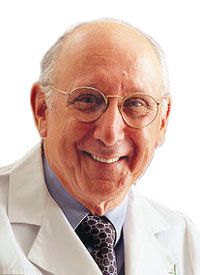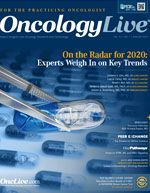Publication
Article
T-Cell Immunotherapy Pioneer Seeks New Direction for Solid Tumors
Author(s):
CAR T cells are a highly active field of investigation, with many companies at work on formulations they hope to bring to market, but these agents have limitations, particularly with metastasized solid tumors.
Steven A. Rosenberg, MD, PhD, chief of surgery in the National Cancer Institute

Steven A. Rosenberg, MD, PhD
CAR T cells are a highly active field of investigation, with many companies at work on formulations they hope to bring to market, but these agents have limitations, particularly with metastasized solid tumors. For genuine success against solid tumors, adoptive cellular therapy (ACT) must move in a different direction, says Steven A. Rosenberg, MD, PhD, chief of surgery in the National Cancer Institute and a 2013 winner of the Giants of Cancer Care® award for immunotherapy.
“I’ve stopped working with CAR T cells because I see only limited value with those in solid tumors,” said Rosenberg, an early pioneer of CAR T cells in lymphoma and now an advocate for the development of neoantigen-directed lymphocyte therapy.
CAR T cells can be engineered to recognize a protein on the surface of a cancer cell, such as CD19. “Nothing would please me more than to use a CAR T cell against solid tumors. The problem is, there are limited targets that the CAR T cells can recognize,” Rosenberg said.
A vastly more promising approach, which has demonstrated remarkable success in selected patients, uses the patient’s own tumor-infiltrating lymphocytes (TILs) that can recognize cancer-specific antigens, he said. This involves either identifying immune cells that already recognize cancer-specific antigens, or genetically engineering T cells with genes encoding T-cell receptors (TCRs) that recognize the protein products of cancer mutations. These cells, expanded ex vivo, target the cancer directly and spare normal cells. They have produced examples of durable regression across solid tumor types in clinical trials.
Rosenberg said that studies of tumors from over 100 patients with metastatic epithelial cancer types showed that 70% to 80% of patients had T-cell responses to specific mutations in their cancer. On average, 1% to 2% of mutations are immunogenic.
Epithelial cancers are responsible for roughly 90% of cancer mortalities each year, or 550,000 deaths in the United States, and the existing armamentarium of therapies is inadequate, according to Rosenberg. “Chemotherapy and targeted therapies are making incremental advances. None are curative for the patients with solid metastatic cancers,” he said. “Checkpoint modulators represent a major advance. They can be very effective in melanoma, kidney cancers, and non—small cell lung cancers, though most patients with metastatic epithelial cancers are not going to be cured by the current use of these agents.”
The targeting of mutated proteins expressed by the cancer cells using the patient’s own lymphocytes, naturally arising in the host or genetically engineered in the laboratory to attack cancer, is emerging as a treatment with great potential.
In a 2016 paper, Eric Tran, working with Rosenberg and other investigators, described using this approach to successfully treat a patient with metastatic colorectal cancer. TILs targeting the mutation KRAS G12D induced regression of all 6 lung metastases following infusion.1 In this study, 1 cancer lesion had evolved to avoid detection by the patient’s TILs. This was removed and the patient remains disease free over 4 years later.
Similar success was reported for a patient with metastatic cholangiocarcinoma via the use of TILs targeting a mutation in the protein ERBB2IP.2 Prior to cell infusion, there was clear evidence of progressive disease, but “tumor regression occurred, and the patient is living disease-free over 6 years later,” Rosenberg said.
A 2018 report in Nature Medicine described success against chemorefractory hormone-positive metastatic breast cancer in a patient who was treated with TILs reactive to 4 mutated proteins: SLC3A2, KIAA0368, CADPS2, and CTSB. At time of the report, the response had been ongoing for >22 months, and the patient remains disease free over 4 years later.3
Rosenberg led each of those studies. “The approach is a potential blueprint for the treatment of many cancers,” he said.
There are barriers to the commercialization of treatment with “natural T-cell therapy,” he said. ACT with TILs and TCRs is a highly personalized, labor-intensive form of medicine. Rosenberg’s laboratory has developed high-throughput screening methods to identify cancer mutations that were immunogenic, or recognized by the patient’s T lymphocytes, but there’s much more to the process.
“You have to take out cells from the patient with cancer, identify which cells can recognize the cancer, target those cells or receptors against the unique mutations in that person’s cancer, and treat the patient with the patient’s own cells that can recognize the cancer. It’s complex and expensive,” he said.
Furthermore, it’s not a one-size-fits-all approach. At present, the full process must be repeated for each patient, posing a barrier to commercialization. ACT using TILs and TCRs is not like a vial of medicine that can be purchased off the shelf and will work with roughly equivalent efficacy in every patient. “That’s the bad news. Almost every patient’s TILs recognize mutations that are unique to that patient’s own cancer,” Rosenberg notes.
The uniqueness of the immune response between patients was illustrated by Rosenberg’s study of patients with common gastrointestinal cancers. Investigators identified 124 neoantigen-reactive TIL populations via whole-exome sequencing of biologic samples from 75 patients. They found that 1.6% of somatic mutations expressed by autologous tumor cells were recognized by TILs cultured from 83% (62) of patients. “Ninety-nine percent of the neoantigenic determinants appeared to be unique and not shared between patients,” the authors wrote (Figure).4
For this reason, Rosenberg considers TIL-TCR therapy to be equivalent to creating a unique drug for each patient with cancer. However, he strongly believes this form of ACT is a better mousetrap: The success he and other investigators are achieving in the laboratory will serve as a magnet for industry. “The genius of industry will figure out ways to make it applicable,” he said. Rosenberg’s lab is working with various companies, including Iovance Biotherapeutics and Kite Pharma, that are attempting to “take our findings out to the public at large,” he said.
Figure. Mutation Profiles Differ
The good news is natural TIL-TCR therapy’s potential universality, Rosenberg said: “Since cancer is caused by an accumulation of mutations, every cancer has mutations that are expressed in the cancer cell. Potentially, many cancers are eligible for this kind of treatment. It’s not dependent on any histology.” 








